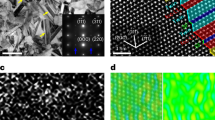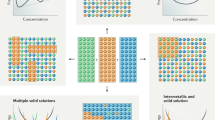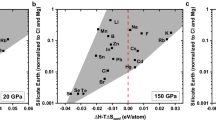Abstract
Seismic anisotropy provides an important observational constraint on flow in the Earth's deep interior. The quantitative interpretation of anisotropy, however, requires knowledge of the slip geometry of the constitutive minerals that are responsible for producing rock fabrics. The Earth's lower mantle is mostly composed of (Mg, Fe)SiO3 perovskite1, but as MgSiO3 perovskite is not stable at high temperature under ambient pressure, it has not been possible to investigate its mechanical behaviour with conventional laboratory deformation experiments. To overcome this limitation, several attempts were made to infer the mechanical properties of MgSiO3 perovskite on the basis of analogue materials2,3,4,5,6,7. But perovskites do not constitute an analogue series for plastic deformation, and therefore the direct investigation of MgSiO3 perovskite is necessary. Here we have taken advantage of recent advances in experimental high-pressure rheology8 to perform deformation experiments on coarse-grained MgSiO3 polycrystals under pressure and temperature conditions of the uppermost lower mantle. We show that X-ray peak broadening measurements developed in metallurgy can be adapted to low-symmetry minerals to identify the elementary deformation mechanisms activated under these conditions. We conclude that, under uppermost lower-mantle conditions, MgSiO3 perovskite deforms by dislocation creep and may therefore contribute to producing seismic anisotropy in rocks at such depths.
This is a preview of subscription content, access via your institution
Access options
Subscribe to this journal
Receive 51 print issues and online access
$199.00 per year
only $3.90 per issue
Buy this article
- Purchase on Springer Link
- Instant access to full article PDF
Prices may be subject to local taxes which are calculated during checkout



Similar content being viewed by others
References
Ringwood, A. E. Phase transformations and their bearing on the constitution and dynamics of the mantle. Geochim. Cosmochim. Acta 55, 2083–2110 (1991)
Poirier, J. P., Peyronneau, J., Gesland, J. Y. & Brebec, G. Viscosity and conductivity of the lower mantle; an experimental study on a MgSiO3 perovskite analogue, KZnF3 . Phys. Earth Planet. Inter. 32, 273–287 (1983)
Beauchesne, S. & Poirier, J. P. Creep of barium titanate perovskite: a contribution to a systematic approach to the viscosity of the mantle. Phys. Earth Planet. Inter. 55, 187–199 (1989)
Beauchesne, S. & Poirier, J. P. In search of a systematics for the viscosity of perovskites: creep of potassium tantalate and niobate. Phys. Earth Planet. Inter. 61, 182–198 (1990)
Wang, Z. C., Karato, S. & Fujino, K. High temperature creep of single crystal strontium titanate (SrTiO3)—a contribution to creep systematics in perovskites. Phys. Earth Planet. Inter. 79, 299–312 (1993)
Li, P., Karato, S. I. & Wang, Z. High-temperature creep in fine-grained polycrystalline CaTiO3, an analogue material of (Mg, Fe)SiO3 perovskite. Phys. Earth Planet. Inter. 95, 19–36 (1996)
Wang, Z. C., Dupas-Bruzek, C. & Karato, S. High temperature creep of an orthorhombic perovskite—YAlO3 . Phys. Earth Planet. Inter. 110, 51–69 (1999)
Chen, J. H., Weidner, D. J. & Vaughan, M. T. The strength of Mg0.9Fe0.1SiO3 perovskite at high pressure and temperature. Nature 419, 824–826 (2002)
Horiuchi, H., Ito, E. & Weidner, D. J. Perovskite-type MgSiO3: single-crystal X-ray diffraction study. Am. Mineral. 72, 357–360 (1987)
Cordier, P. & Rubie, D. C. Plastic deformation of minerals under extreme pressure using a multi-anvil apparatus. Mater. Sci. Eng. A 309, 38–43 (2001)
Caglioti, G., Paoletti, A. & Ricci, F. P. Choice of collimators for a crystal spectrometer for neutron diffraction. Nucl. Instrum. Methods 3, 223–228 (1958)
Krivoglaz, M. A. Theory of X-ray and Thermal Neutron Scattering by Real Crystals (Plenum, New York, 1969)
Krivoglaz, M. A. X-ray and Neutron Diffraction in Nonideal Crystals (Springer, Berlin, 1996)
Wilkens, M. The determination of density and distribution of dislocations in deformed single crystals from broadened x-ray diffraction profiles. Phys. Status Solidi 2, 359–370 (1970)
Kuzel, R. & Klimanek, P. X-ray diffraction line broadening due to dislocations in non-cubic crystalline materials. 3. Experimental results for plastically deformed zirconium. J. Appl. Crystallogr. 22, 299–307 (1989)
Ungár, T. & Borbély, A. The effect of dislocation contrast on x-ray line broadening: a new approach to line profile analysis. Appl. Phys. Lett. 69, 3173–3175 (1996)
Ungár, T., Gubicza, J., Ribárik, G. & Borbély, A. Crystallite size distribution and dislocation structure determined by diffraction profile analysis: principles and practical application to cubic and hexagonal crystals. J. Appl. Crystallogr. 34, 298–310 (2001)
Ribárik, G., Ungár, T. & Gubicza, J. MWP-fit: a program for multiple whole-profile fitting of diffraction peak profiles by ab initio theoretical functions. J. Appl. Crystallogr. 34, 669–676 (2001)
Karato, S. I. Plasticity of MgSiO3 perovskite: the results of microhardness tests on single crystals. Geophys. Res. Lett. 17, 13–16 (1990)
McNamara, A. K., vanKeken, P. E. & Karato, S. I. Development of anisotropic structure in the Earth's lower mantle by solid-state convection. Nature 416, 310–314 (2002)
Merkel, S. et al. Deformation of (Mg0.9,Fe0.1)SiO3 perovskite aggregates up to 32 GPa. Earth Planet. Sci. Lett. 209, 351–360 (2003)
Acknowledgements
High-pressure experiments were performed at the Bayerisches Geoinstitut under the EU ‘IHP–Access to Research Infrastructures’ programme. P.C. benefited from a ‘Congé thématique pour recherche’ from the University of Lille and from continuous support from INSU (‘Intérieur de la Terre’ programme). T.U. and G.T. thank the Hungarian Science Foundation for supporting this work
Author information
Authors and Affiliations
Corresponding author
Ethics declarations
Competing interests
The authors declare that they have no competing financial interests.
Rights and permissions
About this article
Cite this article
Cordier, P., Ungár, T., Zsoldos, L. et al. Dislocation creep in MgSiO3 perovskite at conditions of the Earth's uppermost lower mantle. Nature 428, 837–840 (2004). https://doi.org/10.1038/nature02472
Received:
Accepted:
Issue Date:
DOI: https://doi.org/10.1038/nature02472
This article is cited by
-
Remnants of shifting early Cenozoic Pacific lower mantle flow imaged beneath the Philippine Sea Plate
Nature Geoscience (2024)
-
The role of diffusion-driven pure climb creep on the rheology of bridgmanite under lower mantle conditions
Scientific Reports (2019)
-
Upper- and mid-mantle interaction between the Samoan plume and the Tonga–Kermadec slabs
Nature Communications (2016)
-
Mantle dynamics inferred from the crystallographic preferred orientation of bridgmanite
Nature (2016)
-
Texture development and slip systems in bridgmanite and bridgmanite + ferropericlase aggregates
Physics and Chemistry of Minerals (2016)
Comments
By submitting a comment you agree to abide by our Terms and Community Guidelines. If you find something abusive or that does not comply with our terms or guidelines please flag it as inappropriate.



